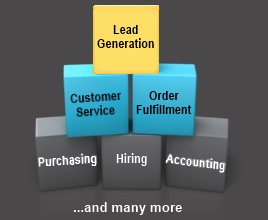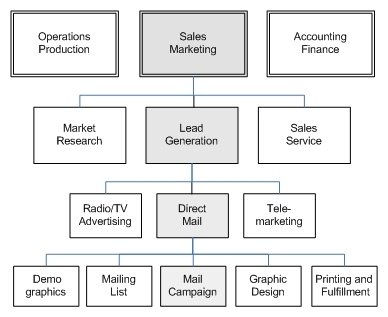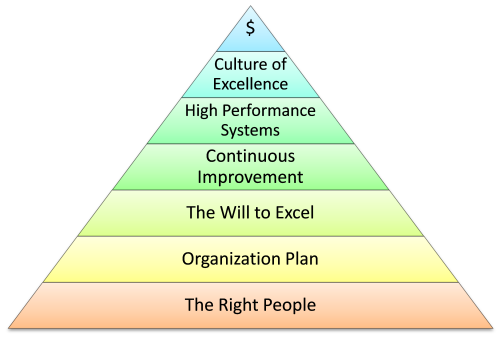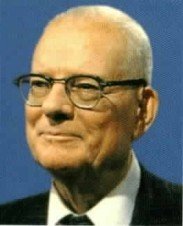In recent posts, I have discussed the basic principles found in the widely used business-improvement methodologies of Six Sigma, Lean Thinking, and the Theory of Constraints. This article will focus on the Box Theory™ Way, and why it is the best solution for small and mid-size companies.
All four improvement methodologies seek to create a business culture that produces high value for shareholders, customers, and employees. These strategies also have several common objectives.
- Respect individuals and their power to make a difference
- Continually improve people, products and processes
- Eliminate waste to reduce cost and increase value
- Develop a culture of discipline and excellence
- Build long-term value into the business
Like its three big brothers, Box Theory™ is driven by a compelling principle the Japanese call “kaizen”—the ongoing, systematic, incremental improvement in the way things are done. However, Box Theory™ integrates the other three often complex and expensive business process management (BPM) techniques into a simple, intuitive, and low-cost solution for small-business owners.
Origin of Box Theory™
As an entrepreneur for over forty years, I have learned the value of having effective operating systems and processes. Early one morning, while considering the vital role of business systems for my accounting clients, I was inspired by a concept now known as Box TheoryTM. It is a simple statement with profound implications. I explain it fully in my eCourse, Box Theory™: Double Your Profit with High-Performance Systems and Processes.”

The Box Theory™ Way allows any organization to be viewed through a lens that magnifies operational details, revealing the root-cause of problems and clear solutions. It is based upon enduring principles found in Nature. The more I work with Box Theory™, the more elegant it becomes as if God revealed one of his secrets for creating and managing the universe. I have not yet discovered its full potential!
The mission and purpose of Box Theory™ for small business is to help owners dramatically increase customer loyalty, profitability, and growth by elevating the performance of their vital business systems and processes.
Systems are Your Building Blocks
To understand Box Theory™, it is important to recognize the basic nature of a business with its underlying structure of systems and processes.
In short, every business consists of people, products, and daily processes organized to profitably find and keep customers.
A business system is a procedure, process, method, or course of action designed to achieve a specific outcome. Its component parts and interrelated steps work together to accomplish an operational objective. Creating effective business systems is the only way to attain results that are consistent, measurable, and ultimately benefit customers.
Business systems, such as lead generation, customer care, hiring, purchasing, production, order fulfillment, and many others unique to each company, are the essential building blocks of a successful and profitable organization. Every facet of a business—in the workshop, the office, the retail store, or the factory—consists of systems that can be managed and improved by applying correct principles. The Law of Cause and Effect governs all system results.

Good business systems increase efficiency, accomplish objectives, and give customers what they want every time. They are the solution to weak sales growth, low profit, dissatisfied or too few customers, waste and inefficiency, underperforming employees, excessive costs, poor cash flow, and daily frustration—every business problem! Effective systems and processes make products and services better, faster, and cheaper.
Many small-business owners have rudimentary systems haphazardly created by employees, and which change as workers come and go. These low-grade systems are not documented, measured, or steadily improved. In Box Theory™, detailed procedures, performance standards, and accountability replace generalized solutions, seat-of-the-pants operations, employee discretion, and everything else that might be left to chance. Good business systems reinforce, “This is how we do it here (until we find a better way)!”
Michael Gerber, the author of E-Myth Revisited, advised, “Organize around business functions, not people. Build systems within each business function. Let systems run the business and people run the systems. People come and go but the systems remain constant.”
Creating effective business systems is both an art and a science. It requires creativity and innovation as well as logic, organization, and discipline.
Good systems pay for themselves many times over, and the larger the company the greater the benefit. In fact, says Ken Stork, former president of the Association of Manufacturing Excellence, “If you need a new process and don’t install it, you pay for it without getting it [in waste and inefficiency].”
Small business owners should not dismiss process improvement methods as the exclusive domain of large companies. Developing—or overseeing the development—of effective business systems and processes is the Master Skill of the entrepreneur. All business functions—marketing, finance, and operations—fall within the scope of this single skill mastery. The real value of a business is found in the maturity of its business systems—their ability to consistently produce desired results.
The Box Theory™ Way
Box Theory™ is patterned after systems in our natural world—solar systems, ecosystems, weather systems, human body systems, and so forth. Through time, man has wisely followed the systems model to solve problems and advance to new plateaus. A few examples include farming systems, energy systems, highway systems, and Internet systems.
In nature, all matter is made up of molecules. Molecules are made of atoms, and atoms are composed of atomic particles (protons, electrons, and neutrons). Modern science has discovered quarks inside the atomic particles. And more recently, physicists have mathematically proven that even smaller energy strings are the basis of everything in our universe (String Theory).
Likewise, Box Theory™ is a methodology and software that breaks business functions down to manageable systems and subsystems, the “boxes” of a procedural flowchart. For example, a typical marketing system box will have a subsystem box called lead generation. The lead generation system could have lower-level subsystem boxes such as direct mail, telemarketing, or radio advertising. In Box Theory™, system and subsystem boxes form the framework of all business activities. These boxes cascade down the organization chart with ever-increasing specificity and detail.

Problems and profits are uncovered in the low-level boxes of an organization’s core systems and processes.
Improvement efforts, using the basic principles of Six Sigma, Lean Thinking, and the Theory of Constraints, are applied to a company’s vital systems and processes to elevate their performance. The Pareto Principle—the 80-20 Rule—suggests that 20% of system boxes account for 80% of business results. The Box Theory™ Way prioritizes improvement projects to get fast results with the biggest payoff.
When applying Box Theory™, seven high-performance attributes are potentially associated with a business system. Each attribute is a quality that improves the output of the system. Thus, you can elevate the performance of any system—or box—by taking steps to increase the number of its high-performance attributes. For example: If the business system has an owner with accountability, it will achieve far better results than a system without an owner. This attribute and six others are discussed in the eCourse.
As with Six Sigma, Lean Thinking, and the Theory of Constraints, a primary purpose of Box Theory™ is to remove waste from the business. Each methodology views waste from a different perspective. In Box Theory™, waste is simply an underperforming box—a business system, subsystem, or step in a process that is a weak link or bottleneck, fails to add value to customers or is characterized by excessive defects, delay, or deviation from standards.
Prioritization + Focus = Fast Results
There are only two ways to get better results from any business system. Improve the procedure, or improve the component parts used in that procedure (including people). To improve an individual system or process, Box Theory™ focuses on six essential areas—process, components, people, quality, speed, and measurement.
- Process – Effective systems—in the office, the store, or the factory—are well designed, smooth running, evenly paced, and use standardized procedures. They seek to eliminate idle time, mistakes, unnecessary movement, bottlenecks, downtime, and work-in-process or inventory buildup. You make money when the system-flow is stable, steady, and sustained (more like the tortoise than the hair in the children’s fable).
- Components – A system must have all the necessary components to function properly such as checklists, forms, scripts, reports, brochures, equipment, software, supplies, tools, equipment, people, and other resources. Missing or poor-quality system components are a major weakness of most small businesses.
- People – Respect for people is paramount. They are the most important (and often the most expensive) system component. Put the right people in the right job with effective training, trust, empowerment, and accountability. Well conceived business systems leverage ordinary people to produce extraordinary results.
- Quality – Good systems must have minimal mistakes, waste, and rework to keep costs down. Products or services are delivered as promised, and free of defects. They meet or exceed customer specifications and expectations. Any quality considerations that are critical to the customer must be critical to the business owner, or the customer will go elsewhere.
- Speed – Efficient business systems have short lead-times and high throughput by squeezing delay, bottlenecks, and “speed bumps” out of the process. They run fast enough to deliver on schedule or by deadlines. Speed creates higher employee productivity and work satisfaction, increased capacity for sales, faster invoicing and cash flow cycles, lower costs, and happier customers who will buy again.
- Measurement – Renowned business authority Peter Drucker says, “You cannot manage what you cannot measure.” Continuous measurement and worker feedback guide all process improvement. Determine what measurements drive the “economic engine” of your business. Establish process measures that let workers know every day how they are doing in relation to business goals.
By applying the six areas of focus, a Box Theory™ organization will:
- Meet and exceed customer expectations, solving customer problems quickly.
- Turn customers in raving fans with consistency, quality, speed, and reliability.
- Create clear job descriptions and performance expectations for employees.
- Reduce employee training and supervision, and dependency on people who come and go.
- Create high job satisfaction and reduced employee turnover.
- Dramatically increase productivity, quality, safety, and cleanliness.
- Reduce waste and inefficiency, and thereby lower costs.
- Improve cash flow and profit.
- Build long-term value into the business to eventually sell or replicate.
Box TheoryTM Gold Software Tool
The Box Theory™ method of breaking down a business into its interrelated systems and subsystems—the boxes—is incorporated into a robust software tool that guides every step of System Thinking and process improvement. With Box Theory™ Gold software, an organization can do the following to elevate its performance:
- Maintain an Organization Blueprint—mission, values, strategy, goals, and structure—that serves as a foundation for building all business systems and processes. System goals can be aligned with the larger company goals; people and systems push together to accomplish the vision of the organization.
- Identify and define every major system and subsystem necessary to run an organization. Begin by developing or improving systems that provide the biggest financial payoff.
- Create, flowchart, organize, manage, document, store, and print everything pertaining to the organization’s systems and processes. This library of “the way we do things here” becomes a valuable asset, allowing the business to be replicated in new markets, sold for top dollar, or run without the hands-on involvement of the owner.
Box TheoryTM Gold is a complete and indispensable tool for managing the many details of an organization. It is as important to system development as QuickBooks is to accounting. Box Theory™ Gold is the best way for small-business owners to work on their business, not just in their business (Michael Gerber, E-Myth Revisited), and get results in half the time!
Culture of Excellence
“An organization’s purpose and goals set the direction. Measures focus the energy on the outcomes. Processes create habits, and habits drive the culture. You can teach skills and concepts. You can even create momentum (and a few smiles) through inspiration. But investing in skills and inspiration is a waste of money if there are no processes to reinforce your purpose and principles. The creation and continuous refinement of work processes is a mandatory practice in the Results Rule! organization, regardless of the industry” (Randy, Pennington, Results Rule!, 111).
The Box Theory™ Way helps business owners create a culture of discipline and excellence—a culture that includes the right people, a good plan, the will to excel, a philosophy of continuous improvement, and high-performance business systems and processes.

A Box Theory™ organization exists when people work individually and collectively at their maximum potential—even when the owner is not around. A culture of excellence will provide the highest value for shareholders, customers, and employees.
Get Started Today!
Box TheoryTMis an actual statement of theory rooted in Natural Law and fully described in the eCourse. It applies to all business-building activities and every type of organization. Box Theory™ is the practical application of knowledge, principles, strategies, and best practices to develop high-performance business systems, and to create exceptional organizations. It is the premier “system” to start, grow, fix or franchise any business.
Box Theory™ Gold software is also a revolutionary new tool designed specifically for small and mid-size companies. It is simple and easy to learn. The software program promotes Systems Thinking and business development skills, using powerful process-improvement techniques. Once you try Box Theory™ Software, you’ll never go back to the old way of doing business.
As the marketplace evolves, the bar is constantly rising. Organizations have to get better at what they do every year to in order to survive and prosper. A decision to learn the Master Skill of developing effective business systems and processes is one of the most important a business owner can make. I invite you to become a Systems Thinker today and let me show you a new and better way—the Box Theory™ Way.
Related Articles
Six Sigma for Small Business—Improve Quality!
The Theory of Constraints for Small Business—Eliminate Bottlenecks!
Lean Thinking for Small Business–Add Value!
10 Values of a Systems Thinker
Business Systems 101 Video Webinar (17 min)







